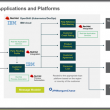Sibos 2022: Are banks progressive about product?
What is the most recent product innovation for retail customers to come from high-street banks?

Are banks progressive about product?
I asked this question to a group of well-respected friends and colleagues in the banking industry. The most popular responses were things that related to access like apps or internet banking or features like personal finance management. Some people said buy now, pay later (BNPL), P2P and crowdfunding, however none of these were created by banks.
In the world of payments, we’ve seen players like PayPal, Stripe and Wise grow successfully. However, aside from product features like reward programmes (bundling) and cashback, banks have not really innovated here either.
So, to answer my own question, I believe the last real example of “product innovation” to come from a bank was the offset mortgage in the 90s. That would make it almost 30 years since banks innovated on products for retail customers. Just to be clear, by innovation I mean anything that fundamentally changes the way an existing product operates or which simply wasn’t available before. Based on this definition, you could argue for internet/mobile banking, but we would be arguing about interpretation and missing the point about really rethinking products.
As mentioned above, existing products have been reimagined from outside of banks, and this continues to be the case. To make my point, let me give three examples of companies being far more progressive in redefining products to solve customer pain points:
- UnitPlus – making investments more accessible.
- SavingBlocks – providing exceptional returns for savers.
- Metro AG – providing rewards without switching banks.
UnitPlus is a German fintech that looked to solve a problem that many investors can relate to, and that is investing your money means tying it up for a period of time. This is because the actual investment has to be liquidated (traded) and that is not as simple as going to a cashpoint and withdrawing cash. On top of that, you’d need to think carefully as frequent withdrawals would be costly due to trading fees.
UnitPlus customers can now invest in a range of ETFs and have a card that they can spend with against their investments. Behind the scenes, the money to pay for transactions is made available through necessary trades of the ETF(s), however transaction fees are no more than what credit cards charge.
How all this is possible is the intellectual property of UnitPlus. Whether we all want this is also a separate issue, though there is a generation of younger adults who want more for their money than the small percentages that banks pay while accepting some risk on the investment. The key point about UnitPlus is that it saw the customer problem of liquidity (accessibility) of funds in an investment and sought to solve that problem.
SavingBlocks is a start-up targeting savers that want better returns for their money. While a low interest rate world is now starting to change, many savers have lost out over the last 20 years with savings rates at 1% or less and will continue to lose out with rising inflation.
Cryptocurrencies have made huge gains and losses, and as such they remain volatile investments. However, not all crypto investments have such a high risk. There are a number of ways of getting returns (yield) without buying specific coins (investments) such as staking and lending. The challenge here though is the complexity of dealing with different platforms, and crypto is notorious for not being user friendly.
SavingBlocks has developed its own interfaces for these types of investments and is aiming to solve the “usability” issue. Its investment strategy only selects investments that have 1:1 backing with real-world assets – for example, collateralised stablecoins. On top of this, the firm insures its investments to reduce risks further. By addressing the usability and volatility issue of crypto, SavingBlocks offers its customers higher yields than banks and at lower risk than investing in crypto directly.
Metro AG is another German non-financial organisation entering the world of financial services, this time through embedded finance. Although the company is not targeting retail customers, its model is very interesting, and I can see how this could be used by others in the retail market.
Metro is a wholesale product provider to restaurants and hotels. It saw its customers moving towards digital some time back and also saw how traditional banks were starting to lose engagement with their customers through open banking. It saw that its customers were underserved by banks and sought to provide solutions for their needs. The firm’s first two products address the following pain points:
- Customers have money in their account that is not earning interest.
- Customers need to improve their cashflow.
To solve these problems, Metro launched a decoupled credit card, basically a card that sits on top of a customer’s existing bank account. Metro then provides cashback on all card spend. In the background, their bank account is debited for transactions on the day. Metro ensures the customer has available funds by checking their balance four times a day. The customer is then rewarded and Metro gains customer loyalty. Better still, the firm now directly understands where the customer is spending money, effectively taking valuable data/engagement away from the host bank. This is made possible by open banking and the smart use of technology.
For the second problem, Metro has created its own BNPL option, something that can be used online and offline for every purchase that has been made with the Metro card, independent of whether the purchase was made at Metro or another merchant.
Banks have invested millions in innovation in different ways (funding, incubation, partnering and so on) and for different reasons (new technology and new markets, for example). However, little if anything has come from this in terms of “products” launched to customers, and it is clear that start-ups not encumbered with the legacy technology and processes of banks are more easily able to understand customer problems to reimagine solutions and products.
This is not just the innovator’s dilemma, as Clayton Christensen puts it, this is more about the legacy of the organisation and of the industry. Start-ups are able to challenge the norm because they have no legacy. They are able to test the boundaries of regulations quite often first by breaking their rules.
What is clear though as the tech landscape expands at an ever-faster pace is that while the breadth of innovation outside of banks might not be a challenge to their existence, it will certainly limit new growth opportunities. This certainly matters when growth in banking has slowed dramatically since the financial crisis of 2007/08.
About the author
Dharmesh Mistry has been in banking for more than 30 years and has been at the forefront of banking technology and innovation. From the very first internet and mobile banking apps to artificial intelligence (AI) and virtual reality (VR).
He has been on both sides of the fence and he’s not afraid to share his opinions.
He is CEO of AskHomey, which focuses on the experience for households, and an investor and mentor in proptech and fintech.
Follow Dharmesh on Twitter @dharmeshmistry and LinkedIn.
Read all his “I’m just saying” musings here.












































